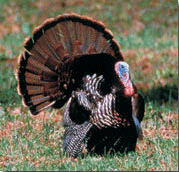TREE TALK
Originally published in Capital on January 18, 2008

The Eastern Wild Turkey
One of the Largest Birds Found in North America
In continuing the discussion on the native inhabitants of the eastern forest, we’ll turn our attention to one of the largest birds found in North America: the wild turkey, Meleagris gallopavo. The eastern wild turkey, Meleagris gallopavo sylvesteris, is one of six subspecies of wild turkey found in North America. A strikingly beautiful animal, the wild turkey in males average 18 pounds in weight with an average wingspan of 4.5 feet. Females are about one third smaller on average. They are big birds. The largest known specimen was a male that weighed just over 38 pounds! That's a bit larger than the standard oven can handle.
They are of course related to the domestic turkey but aside from their size and appearance they are quite different in behavior. Most notably Wild turkeys are one of the most intelligent birds to be found anywhere and have very keen vision. They also see in color, which is somewhat of a rarity in the animal kingdom. They are classified as gallinaceous or chicken like birds, with large legs and stubby wings. When threatened turkeys will run away on their powerful legs and they are very quick. But, they are also strong fliers and can fly in bursts up to 50 miles per hour for short distances.
Wild turkeys are also known as bearded turkeys, with males having a slender ‘beard’ that hangs from its chest that averages 8 inches long. It’s not an exclusive trait of males though, for as many as 20% of females have beards too. The male turkey, like many birds, are the most colorful of the species, having featherless red heads and feathers that include areas of red, purple, green, copper, bronze, and gold iridescence. Their tails are fan-shaped and banded and their wings have striped feathers. The females are more brownish black helping them blend in to their surrounding better.
Wild turkeys are more often found in hardwood forests where they feed on acorns and seeds, grasses, insects and small reptiles. At night they roost in trees to stay away from predators. They have poor vision at night and prefer to stay out of harms way when predators such as foxes and bobcats are on the prowl. Great horned owls, the king of all predators in the Eastern forest will also take adults.
The most interesting behavior of turkey, like many birds, occurs when they mate. Turkeys are polygamous similar to whitetail deer and a male will gather a harem of females together and defend them from rival males. Male turkeys will strut for the females and puff their breast and wings and fan their tails out to impress the females. This is when they are most vocal too. And they are vocal, having at least 20 different calls, including the classic gobble. The males will fight if evenly matched and have stout, sharp spurs on their legs for fighting and defensive purposes.
Spring is the mating season for turkeys around March through April followed by the nesting season. Turkeys nest on the ground and lay 8 to 10 brown spotted eggs. The females will stick to their nest until the eggs hatch, unless you walk up on one like I did. It was a heart stopping experience to say the least.
They are most vulnerable to predators at this time and it's not uncommon to find a pile of feathers in the woods in late spring or summer. If nesting is successful, the baby turkeys - called poults - will after 24 hours start walking around looking for insects. They move to open meadows and fields for this activity. Open field and meadows are a critical element of turkey habitat. Sometimes managers will need to create openings in dense woods to provide this habitat.
Wild turkeys are one of the great success stories for wildlife management. 100 years or so ago it was estimated there were as few as 30,000 in all of the United States. Now through conservation efforts both public and private there are that many in Maryland alone. Most of the credit can be attributed to one group: the turkey hunter. Most of the money for conservation efforts and research come from money collected from the Pittman-Robertson Act. The Pittman-Robertson Act was passed in 1937 and put a 11% excise tax on all rifles, shotguns and ammunition to support wildlife conservation. This was amended in 1970 to include archery and handguns too. In fact, to this day it is a major source of funding for wildlife conservation in general.
Wild turkeys are well established in Maryland and are thriving thanks to conservation efforts and habitat protection. Look for them in the woods and enjoy the sights!
Questions and comments can be directed to
ForestGreenway@comcast.net
Bud Reaves writes Tree Talk for the Anne Arundel County Forest Conservancy
District Board.
Additional Forestry-Related Links
Champion Trees of Anne Arundel County
Big Tree Champions of Maryland
Native Plants for Anne Arundel County
Planting and Care of Your Trees
TREE-MENDOUS MARYLAND
Invasive Species